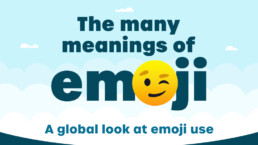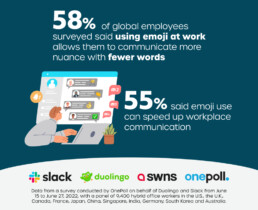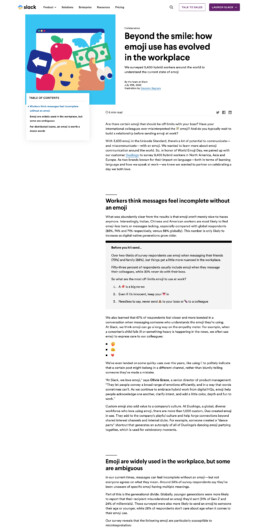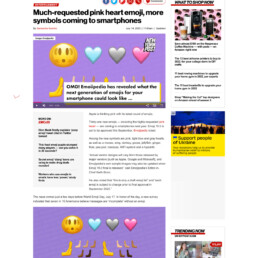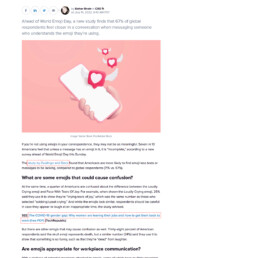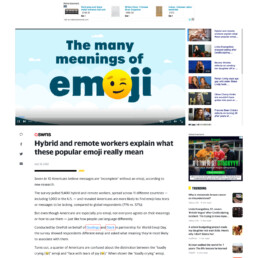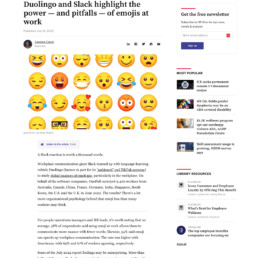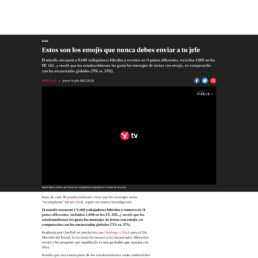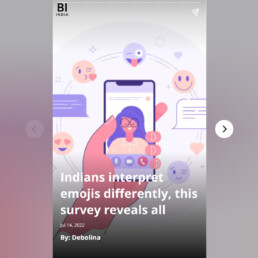
International research & earned media campaign
World Emoji Day
Slack and Duolingo commissioned a OnePoll study to explore emoji communication around the world and how the emoji has evolved in the workplace. We polled 9,400 hybrid workers across 11 different countries.
The international study highlighted how embedded emojis are in everyday communication and revealed fascinating insights into how they’re used and interpreted in different countries.
The survey findings formed the basis of a data-driven news story, written and distributed by our news generation partner 72Point Inc.
9,400
International panelists
114
Pieces of coverage
11,300,000
Online coverage views
35
Links from coverage
Research insights and key findings
Different interpretations of emoji meanings
The survey respondents answered questions about their emoji use and were also shown different emoji to determine what meaning they were most likely to associate with them.
The research revealed Americans are more likely to find emoji-less texts or messages to be lacking, compared to global respondents (71% vs. 57%).
And even though Americans are especially pro-emoji, not everyone agrees on their meanings or how to use them.
A quarter of Americans are confused about the distinction between the “loudly crying (😭)” emoji and “face with tears of joy (😂).” When shown the “loudly crying” emoji, 25% said they use it to show “I’m crying tears of joy” — the same number as those who selected “sobbing/upset crying.”
38% of American respondents said the skull emoji (💀) represents death, but a similar number (34%) said they use it to show that something is so funny, they’re “dead.”
And the eggplant emoji (🍆)? A fifth of U.S. respondents said the eggplant is nothing more than a literal representation of the fruit. That said, 34% of Americans surveyed did say they use the eggplant to show they’re “feeling flirty,” and 14% admit they’ve confused the meaning of that particular emoji.
←←CLICK THE IMAGE TO READ THE SLACK BLOG POST "BEYOND THE SMILE: HOW EMOJI USE HAS EVOLVED IN THE WORKPLACE"
Does emoji meaning differ from country to country?
The international study looked at how emoji usage and meaning can vary across different countries, and at emoji use in the workplace.
For global companies, results showed that emoji may be an easy source of miscommunication — as the meanings can differ greatly depending on where someone is from.
When shown “face throwing a kiss (😘), U.S. respondents were slightly more likely to use it in a romantic way than in a platonic way (34% vs. 26%) — as were Indian respondents (52% vs. 27%), Japan was the opposite: three in 10 Japanese respondents use the kissy face in a platonic sense, compared to 16% who use it romantically.
Do emoji belong in the workplace? The survey showed there’s still a wide range of benefits:
58% of global employees surveyed said using emoji at work allows them to communicate more nuance with fewer words, and 55% said emoji use can speed up workplace communication.
Notably, this was higher in the U.S. — 69% of American respondents said emoji allowed them to communicate in a more nuanced way, while 67% said it sped up communication.
“It’s clear from the results that people are using emoji like any other system of communication: meaning can be subtle, and they’re used differently in various settings,” said Dr. Hope Wilson, Learning and Curriculum Manager at Duolingo.
“Emoji let people convey a broad range of emotions efficiently, and in a way that words sometimes can’t, said Olivia Grace, Senior Director of Product Management at Slack.
Data-driven headlines
Take a look at some of the earned media coverage for the 'World Emoji Day' campaign
Photo credit: header image by Domingo Alvarez E
OnePoll polled 9,400 hybrid & remote workers across 11 countries on behalf of Slack and Duolingo in partnership for World Emoji Day. The international research was conducted between June 15th and 27th 2022.
BrandSlack and DuolingoServicesInternational research, Online survey, News story, Infographic, Media distributionLinkslack.comContact uswww.onepoll.us

